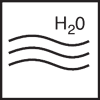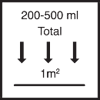Article No. 071005
Aqueous, solvent-free impregnation cream on a silane base
Product specifications
The stated values represent typical product characteristics and are not to be construed as binding product specifications.
Field of application
- Deep hydrophobising of concrete and reinforced concrete in bridge, road and building construction
- Protects against the ingress of de-icing salt
- Protects against damage caused by frost and de-icing salt
Properties
- Improves resistance to frost and de-icing salts
- Repels water
- Enables water vapour diffusion
- Highly concentrated (80% active ingredient content)
- Alkali-resistant
- Excellent long-term effect
- Tested according to the additional technical terms of contract and guidelines for civil engineering works (ZTV-ING), the technical terms of delivery and technical test regulations for surface protection systems (TL/TP OS-A) and the German Committee for Structural Concrete guidelines for the protection and renovation of concrete structures, surface protection systems (DAfStb, RL-SIB OS 1)
- Listed in BASt
- Can be applied sparingly, with absolute precision and with no losses
- Outstanding penetration
- Solvent-free
- UV-resistant
-
Preparation
-
Substrate requirements
The substrate must be clean, dust-free and dry.
-
Preparations
Any construction defects such as cracks, cracked joints, defective connections, rising damp and hygroscopic moisture must be remedied in advance.
Perform any necessary cleaning gently, e.g. by spraying with cold or warm water or by steam-cleaning; use rotec soft whirl jet technology or Remmers cleaning products (e.g. Traffic Film Remover (0671), Clean FP (0666), Clean AC (0672), Combi WR (0675)) on tough stains.
-
-
Application
-
Use a suitable tool to apply the impregnating agent crosswise.
-
Application instructions
-
In order to ensure that the setting of the cement is not disrupted, concrete should be hydrophobised no earlier than two, and ideally four, weeks after production.
The material must not be allowed to come into direct contact with bitumen.
Take appropriate measures to protect adjacent building elements and materials that should not come into contact with the product.
Protect freshly treated surfaces from driving rain, wind, sunlight and condensation.
Remove any excess impregnation agent within 1 hour using V 101 thinner.
-
-
Working tools / cleaning
-
Long-pile lambswool roller, paintbrush.
-
Tools must be clean and dry.
Clean tools with water after use and before any lengthy interruptions to work.
-
Storage / shelf life
-
If stored unopened in its original container in a cool, dry place and protected against frost, the product will keep for at least 12 months.
Use the contents of open containers as quickly as possible.
-
Usage
-
Depending on porosity: approx. 0.2 - 0.5 l/m²
-
Apply to a large enough trial surface (1-2 m²) to determine the precise amount of impregnation agent required.
-
General information
-
Current regulations and legal requirements must be taken into account and deviations from these must be agreed separately.
The relevant test certificates must be observed when planning and carrying out work.
Water must not be allowed to penetrate behind the hydrophobized zone.
Carry out a quantitative analysis of aggressive salts if there are any salts present that could damage building materials.
High concentrations of harmful salts can cause major structural damage that impregnation cannot prevent.
The level of absorption is crucial for the impregnation agent to work at its best. This depends on the respective pore volume and moisture content of the building material.
Testing effectiveness:
The water absorption of mineral building materials can be determined using the Funcosil Test Tube developed by Professor Karsten (Funcosil Facade Testing Kit, article no. 4954).
Testing can only be carried out at the earliest 6 weeks after application.
-
-
Disposal instructions
-
Larger quantities of leftover product should be disposed of in the original containers in accordance with the applicable regulations. Completely empty, clean containers should be recycled. Do not dispose of together with household waste. Do not allow to enter the sewage system. Do not empty into drains.
-
-
Safety / regulations
-
For further information on the safety aspects of transporting, storing and handling the product and on disposal and environmental matters, please see the current Safety Data Sheet.
-











